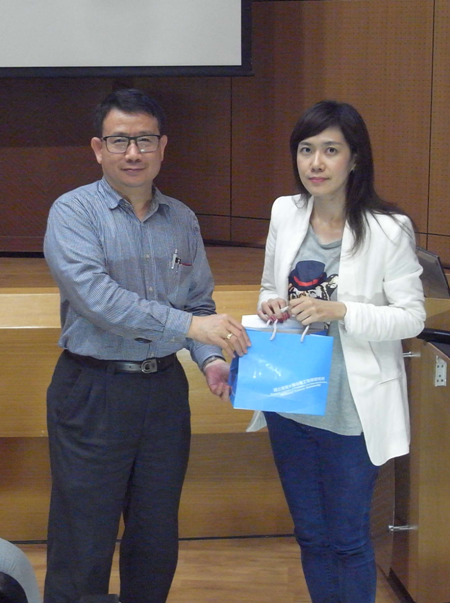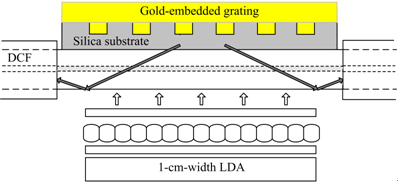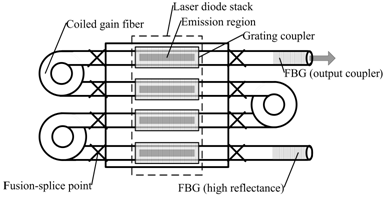 |
|
 |
| |
發行人:林清富所長 編輯委員:陳奕君教授 主編:林筱文 發行日期:2013.05.15 |
| |
|
 |
|
 本所蔡振水教授榮獲「IEEE UFFC-S Achievement Award 2013」,特此恭賀!
本所蔡振水教授榮獲「IEEE UFFC-S Achievement Award 2013」,特此恭賀!
 本所孫啟光教授榮獲「2013潘文淵文教基金會研究傑出獎」,特此恭賀!
本所孫啟光教授榮獲「2013潘文淵文教基金會研究傑出獎」,特此恭賀!
 本所博士生洪士哲、王榆文同學參與本院電資隊榮獲「臺大盃桌球賽青年組冠軍」,特此恭賀!
本所博士生洪士哲、王榆文同學參與本院電資隊榮獲「臺大盃桌球賽青年組冠軍」,特此恭賀!
本所5月份演講公告:
|
日期
|
講者簡介 |
講題 |
地點 |
時間 |
|
光電論壇
|
|
5/17
(Fri) |
边历峰教授
中國科學院蘇州納米技術與納米仿生研究所 |
中國科學院納米器件與應用重點實驗室介紹 |
明達館205室 |
15:30-17:30 |
徐科教授
中國科學院蘇州納米技術與納米仿生研究所 |
HVPE growth of bulk GaN: stress,
threading dislocation, and intrinsic
properties of high-quality GaN |
|
5/24
(Fri) |
陳信吉副處長
TSMC |
待訂 |
博理館
101演講廳 |
15:30-17:30 |
|
|
|
|
 |
|
 |
|
| |
|
 |
|
4月份「光電論壇」演講花絮(花絮整理:姚力琪) |
|
時間: |
102年4月26日(星期五)下午3點30分 |
|
講者: |
陳慧如小姐(編劇、作家) |
|
講題: |
我的寫作人生 |
|
|
陳慧如小姐於4月26日(星期五)蒞臨本所訪問,並於博理館101演講廳發表演說。陳慧如小姐畢業於芝加哥大學社會科學碩士班,主修性別與文化認同研究。曾任商業周刊alive資深記者、MOOK旅遊書資深採訪編輯。現為編劇及作家,作品:電視劇&電影《痞子英雄》、電影《犀利人妻最終回》、電視劇《流氓蛋糕店》、電影《聽不見 我愛你》(獲102年度優良劇本獎佳作)。
本次演講內容主要為分享個人成長經歷及過程。本所教師及學生皆熱烈參與演講活動,演說內容豐富精彩,與現場同學互動佳,本所師生皆獲益良多。 |
| |

陳慧如小姐(右)與本場演講主持人林清富所長(左)合影。
|
|
| |
|
 |
|
 |
|
| |
|
 |
Transient Behaviors of Current-injection Quantum-dot Microdisk Lasers
Professor Ming-Hua Mao's
Laboratory
Graduate Institute of Photonics and
Optoelectronics, National Taiwan University
臺灣大學光電所 毛明華教授
We studied the transient behaviors of current-injection quantum-dot microdisk lasers at room temperature. Unique optical responses were observed, including the suppression of relaxation oscillations and fast turn-on. With the help of rate-equation modeling, the suppressed relaxation oscillations are attributed to the enhanced spontaneous emission factor in microdisk lasers. Short turn-on time, around 1 ns without pre-bias, results from the reduced carrier lifetime caused by the Purcell effect and increased nonradiative recombination rate due to higher surface/volume ratio. With short turn-on time, a large-signal direct modulation experiment at 1 Gbps is demonstrated. Modal transient behavior was also investigated under various temperatures from 100 to 300 K. Both of the transient lasing and steady state lasing from side modes are suppressed at temperatures higher than 250K. Therefore, the quantum-dot microdisk lasers show the potential of single-mode operation under high-speed modulation at room temperature. This work has been published in Opt. Express, Vol. 20, No. 3, pp. 3302, (2012).
|
 |
|
Fig. 1. The temporal optical responses measured from a QD microdisk laser. |
|
 |
|
Fig. 2. The ideal data stream at 1 Gbps, the real electric pulse shape, and the optical responses of the QD microdisk laser with pre-bias. |
|
 |
|
|
Enhancing LED Light Extraction by Optimizing Cavity and Waveguide Modes in Grating Structures
Professor Yih-Peng Chiou's
Laboratory
Graduate Institute of Photonics and
Optoelectronics, National Taiwan University
臺灣大學光電所 邱奕鵬教授
We provided an optimization of light extraction efficiency (LEE) from light-emitting diodes (LEDs). The optimization is achieved when the structural parameters results in good cavity modes in both planar and grating structures, and also when the propagation direction of the fundamental waveguide mode is significantly converted to the direction normal to the grating surface by the gratings. In this research, we use two simple equations, one for cavity modes and the other for waveguide modes, to predict the loci of the optimal structural parameters of gratings. We first obtain the rules by analyzing simple planar structures as illustrate in Fig. 1. (a). Fig. 1. (b) shows the resonant condition by the micro-cavity effect. Fig. 1. (c) shows that the local maximum LEEs appear periodically and are close to the cross of the Fabry-Pérot resonances and the antinodes. The conditions of the resonance at normal incidence and the anitnodes for normal waves are marked by the thick red tics on the bottom and the thick black tics to the right, respectively. Even with the optimization, the LEE of typical planar of LED can only reach up to 30%. To realize ultra-high LEE LED, the source is designed to locate close to the middle of GaN cavity to concentrate the non-radiation power on the fundamental mode and a periodic dielectric wavelength-scaled structure is etched on the mesa surface of LEDs to convert the fundamental guided wave into air mode as schematized in Fig. 2. (a). We modified the resonant condition of normal incident case for grating-assisted system and gave the constructive interference of the emitted waves:

From Fig. 2. (b-c), the local maxima of LEE appear near the intersections of the two equations. The maximum LEE is close to 90% which is triple of that of the planar surface LEDs.
These results verified our prediction.
|
 |
|
Fig. 1. (a) Scheme of optical modes in in thin-film vertical LED. (b) Resonant condition by the micro-cavity effect. (c) Simulation results of LEE. Thick red tics represent the thickness with Fabry-Pérot resonance appearing at normal incidence, and thick black tics express as the antinode factors. |
|
 |
|
Fig. 2. (a) Propagation of waveguide modes in a grating structure. (b-c) Simulation results of the maximum LEE for grating depth versus the GaN
thickness for duty circle=0.3 and 0.5. |
Reference: W.-L. Yeh, C.-M. Fang, and Y.-P. Chiou, “Enhancing LED Light Extraction by Optimizing Cavity and Waveguide Mode in Grating Structures,” IEEE Journal of Display Technology, Vol. 9, No. 5, pp. 359-364, May, 2013.
|
|
| |
|
|
|
 |
|
| |
|
 |
論文題目:高指向性及高效率兆赫波光子發射器之開發
姓名:黃郁儒 指導教授:孫啟光教授
| 摘要 |
|
本論文中,我們提出並實驗證明兩式依垛行開槽陣列天線(rampart slot array
antenna)為設計基礎的兆赫波光子發射器(如圖一、二a)。實驗結果顯示,我們不需使用任何高介電係數的聚焦媒介便可輕易得到高指向性的兆赫波輻射,在0.9兆赫的輻射場型中,不論在電場或磁場平面,其3dB束寬都可被有效地侷限在30度輻射角以內。此外,結合接地共平面波導(grounded coplanar waveguide, GCPW)的新設計(如圖二b),除了保有堅固基板的優點,元件輻射效率及高頻操作更能被有效地提升。其原因在於能夠儲存散逸在電路表面及基板內的兆赫波並形成有效共振。此新設計亦有利於未來的大尺寸光電積體電路整合。
 |
 |
|
圖一、依短路垛行開槽陣列天線(short-circuited rampart slot
array antenna)為設計基礎之兆赫波光子發射器。 |
圖二、(a) 結合共平面波導(grounded coplanar
waveguide GCPW)及開路(open-circuited)垛行開槽陣列天線之兆赫波光子發射器。(b)
共平面波導結構示意圖。 |
|
論文題目:次波長光柵實現半導體雷射陣列側向激發之高功率光纖雷射
姓名:黃玠維 指導教授:黃升龍教授、黃鼎偉教授
| 摘要 |
|
當光纖雷射的激發光源來到擁有更多發光區域之堆疊式雷射陣列(laser diode array, LDA),其在慢軸的多模態發光特性往往使得能被利用的功率受到限制,因此,本論文提出了一種更精巧且更有效率的光柵側向式耦光架構,稱為黃金鑲嵌二氧化矽之光柵耦合器(gold-embedded silica grating coupler);利用此種特殊設計的光柵耦合器,可以直接將半導體雷射陣列及陣列堆疊的光經由側面耦合進雙纖衣光纖(double-clad fiber, DCF)的內層纖衣,如圖一所示。對於一維半導體雷射陣列之側向耦光架構,實驗結果顯示黃金鑲嵌二氧化矽之光柵耦合器能將42瓦,波長976 奈米的連續輸出雷射光,耦合進直徑400 微米之雙纖衣光纖的內層纖衣中,耦光效率為50 %。更進一步,對於多維半導體雷射陣列堆疊(laser diode stack, LDS)側向耦光架構,亦可藉由此光柵耦合器,提升整體耦光功率,同時實現了只使用單一一組半導體雷射陣列堆疊,即達成分佈式側向耦光光纖雷射(distributed side-pumped fiber laser)之架構,如圖二所示。當304.4瓦的半導體雷射陣列堆疊輸出,約124.6瓦的光可被耦合進入雙纖衣光纖之內層纖衣,耦光效率為41 %。更進一步,產生出58瓦的光纖雷射,斜率效率約為50 %,雷射中心波長1090奈米,線寬約為0.11奈米,此窄線寬亦代表了此種分佈式側向激發雷射的優勢。最後,此種光柵側向耦光技術不只能有效率地實現高功率且高品質的雷射光源,同時光柵還能藉由奈米壓印技術來大量生產以降低成本,十分具有商業競爭潛力。
 |
 |
|
圖一、黃金鑲嵌二氧化矽之光柵耦合器示意圖 |
圖二、單一半導體雷射陣列堆疊之分佈式側向耦光雷射系統架構圖 |
|
|
|
 |
|
 |
|
| |
|
 |
—
資料提供:影像顯示科技知識平台 (DTKP, Display Technology
Knowledge Platform) —
—
整理:林晃巖教授、陳聖灝 —
生物顯影:DVD也可以是個實驗室
歐洲的科學家已經成功將商用的DVD傳動裝置轉換成雷射掃描顯微鏡可用於分析血液及達微米解析度的細胞顯影。Harisha Ramachandraiah 與瑞典斯德哥爾摩皇家技術學院(KTH Royal Institute of Technology)的團隊,還有英國Plarion與挪威Lingvitae等公司,聲稱'lab-on-a-DVD'系統針對疾病提供經濟實惠且方便的細胞診斷測試,例如針對人體免疫缺損病毒(HIV)。
這個方法主要在DVD傳動裝置與DVD媒體做了兩個重要的改裝。首先,在傳動裝置上加裝額外的光電二極體來偵測通過碟片的穿透光與向前散射的光。其次,DVD媒體置換為拋棄式、多層的、半透明聚合物碟片,此碟片除了一般0.74
μm寬的螺旋軌道還包含了微流體通道(fluidic microchannels)。
進行實驗之前,流體通道的內表面具有可讓標的細胞與粒子附著於表面之功能。血液或其他有興趣的液體樣本注入通道,同時DVD傳動裝置被打開。附加的光電二極體會記錄當碟片旋轉時從半導體雷射發出的658 nm光所通過的量。如此所產生的結果是一張2維的圖,被儲存至電腦硬碟以供分析。細胞與粒子已成功地被束縛在處理過的通道裡並呈現在結果的圖片中。迄今,團隊已經使用懸浮在溶液中不同大小的聚合物珠粒(1, 2.8 與 5 μm)測試系統,其中有CD4細胞(一種免疫細胞)為HIV病毒的重要指標。(註:若感染愛滋病毒會導致CD4細胞大幅下降。)
研究員現正努力地延展系統的功能以可以處理更大體積的樣本使低濃度物種,如:循環腫瘤細胞可在完整整合的方法下被分析,此方法包含了通道表面修正,洗滌與樣品準備的自動化。

|
|
圖1、夾帶光碟片的雷射掃描顯微鏡系統(DVD-LSM)。(A)雷射掃描顯微鏡系統的概觀。硬體中包含了一具外部馬達以控制旋轉,一個熱電偶用來控制溫度及光電二極體陣列用來測量光,整合至原型並透過個人電腦上的使用者介面來控制。透過個人電腦的軟體做驅動並且經由USB傳輸資料。(B)雷射掃描顯微鏡系統的原理:第二個光電檢測器附加在一般的DVD裝置紀錄散射光的量或吸收收率,收集到的資料集合到圖片檔案中。 |
|
|
|
|
資料來源: |
Oliver Graydon, Bioimaging: Lab on a DVD, Nature Photonics 7, 267 (2013), Published online 27 March 2013, doi:10.1038/nphoton.2013.64
http://www.nature.com/nphoton/journal/v7/n4/full/nphoton.2013.64.html |
|
|
|
|
參考資料: |
Harisha Ramachandraiah, et al., Lab-on-DVD: standard DVD drives as a novel laser scanning microscope for image based point of care diagnostics, Lab Chip
13, 1578-1585, (2013),
doi:10.1039/C3LC41360H |
|
|
|
|
|
|
|
 |
|
 |
|
|
|
 |
|
 |
|